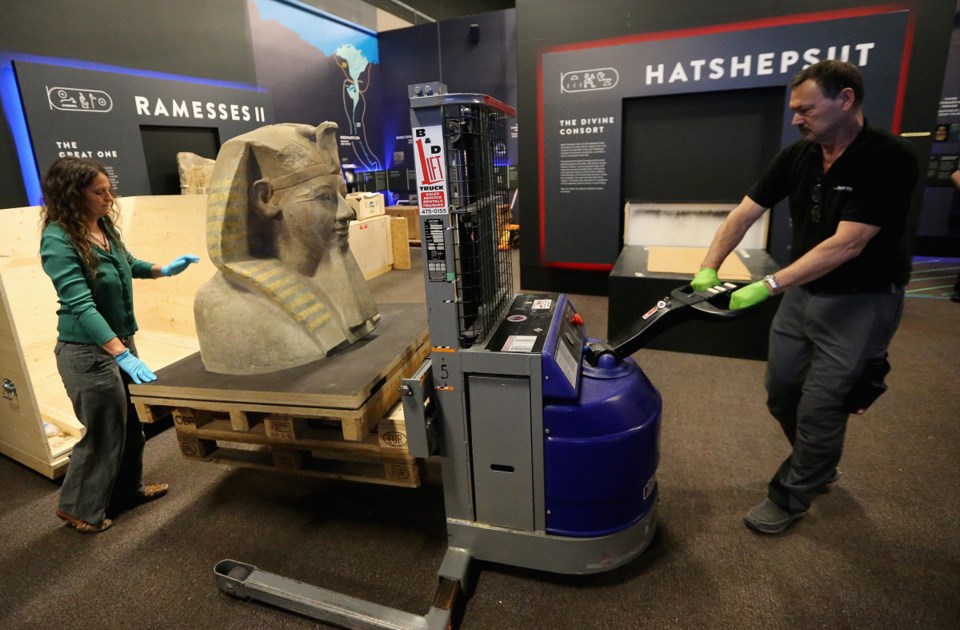Slowly and gingerly, a 3,500-year-old bust of the Pharaoh Hatshepsut was lifted into place with a pallet jack Monday at the Royal B.C. Museum.
At 790 kilograms, the sandstone sculpture doesn’t leave much room for error.
The piece depicts the image of an unusual figure in Egypt’s past — one of the few female pharaohs. But despite that distinction, Hatshepsut almost lost her place in history when her stepson, who was also her successor, had information about her 22-year reign removed from the records.
Her official portraits were destroyed, as well.
It is not known why her stepson took such a step, but researchers were able to pick up her story in 1822 from hieroglyphics on the walls of her tomb.
Hatshepsut’s is just one tale that will be told in an exhibit called Egypt: Time of the Pharaohs, opening May 18 and running through Dec. 31. She is one of six pharaohs to be featured.
The exhibit will not only show how pharaohs ruled, but will also look at many other aspects of Egyptian society, the array of monuments in the country and the natural landscape.
About 350 original artifacts will be on display.
The Hatshepsut bust is on loan from the Egyptian Museum in Berlin. It is one of five museums that have contributed artifacts, including the Museum of Vancouver — which lent some mummified animals.
“To have something monumental like this is really a thrill for us,” Kasey Lee, the Royal B.C. Museum’s senior conservator, said of the bust. “The history, the logistics on getting it here, the care of it once it gets here — it requires a whole lot of planning.”
During its Victoria stay, it will be painstakingly dusted, cleaned and otherwise protected, Lee said.
“Once it gets here, then we have the environment to think about,” she said. “Even stone artifacts can be fragile, especially when the relative humidity rises. And we have to think about the lighting, even stone artifacts have maximum light levels that we use in the galleries.
“So we prepare it that way and then we monitor it after the exhibit opens.”
Christian Walpoth of MuseumsPartner, an Austrian company that manages travelling exhibitions, said the artifacts were brought here in 46 crates of varying size. Overall installation takes three weeks.
He smiled when asked about the potential stress of moving something like the ancient Hatshepsut bust.
“It’s part of the job,” he said. “You get used to it after a while.”
Walpoth he said believes people will enjoy the exhibit. “There are so many unique objects here.”
Michael Barnes, head of exhibitions for the Royal B.C. Museum, said Egypt has long held a special interest for the public.
“We started down this path of getting this exhibition over a year ago.”
Barnes was among a group of museum staff who travelled to Germany to see the exhibition on display. “It was 14,000 square feet at that venue,” he said. “We have only 9,000 square feet here so we edited the show to fit our space.”
Barnes said that Egypt is “one of those timeless topics.”
“It’s got incredible fascination for people,” he said. “There’s a few classics in the museum world and Egypt is definitely one of them.
“Since the first King Tut exhibit toured many years ago, people have been in love with Egypt.”
Barnes said museum staff think that both locals and tourists will be enthralled. “This is, we feel, going to one of our most popular exhibitions in many years.”
He said it is also one of the largest to be brought to the museum in some time, and will be shown in many ways.
“There’s fantastic exhibitry, there’s all kinds of interactive components, there’s multimedia, there’s an incredible selection of scale models, there’s a real variety of visitor experience to see here.”



